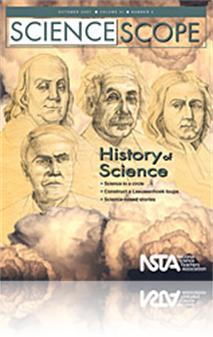All Science Scope resources
Journal Article
Modeling Leeuwenhoek’s Tools With Disposable-Camera Microscopes
When students design and build their own versions of instruments, they appreciate them more—and are more likely to appreciate how experimentation plays a critical role in explaining the world around them (NRC 1999). In this activity, students learn...
Journal Article
Scope on the Skies: Focus on Uranus
It wasn’t until 1781, when William Herschel aimed his six-inch reflecting telescope toward the skies, that our solar system quite literally doubled in size with his discovery of another planet—Uranus. In this month’s column, you’ll learn abou...
Journal Article
Editor’s Roundtable: Don’t know much about history? You should!
We should each examine our curriculum to make sure that we give ample time to the teaching of the history and nature of science. This issue of Science Scope contains a collection of activities and projects, both inquiry- and interdisciplinary-based...
Journal Article
Science Sampler: Weaving women into the science curriculum
Learning about great women in the sciences has the potential to impact mid-level students in a number of ways. These women and their work may serve as important role models, providing encouragement to younger female students. In addition, the stories...
Journal Article
What’s in a Word? How Word Choice Can Develop (Mis)conceptions About the Nature of Science
Despite over 10 years of reform efforts, research still shows that students typically have inadequate conceptions of what science is and what scientists do (McComas 2004; Lederman 2007). Many science students, as well as some teachers, use a single �...
Journal Article
This cooperative activity presents middle school students with the opportunity to explore and discover, as well as enjoy their own communications with one another. By employing reading, writing, and history as an integrated approach to teaching abou...
Journal Article
Teaching Science Using Stories: The Storyline Approach
Storytelling is an age-old and powerful means of communication that can be used as an effective teaching strategy in the science classroom. This article describes the authors’ experiences implementing the Storyline Approach, an inquiry-based teachi...
Journal Article
Tried and True: Our class periodic table
To facilitate discussions centered on the topic of chemistry, students can create a classroom periodic table. In order to accomplish this task, they research elements in the periodic table using various media (textbooks, Internet), and then create a ...
Journal Article
Launch Excitement with Water Rockets
Explosions and fires—these are what many students are waiting for in science classes. And when they do occur, students pay attention. While we can’t entertain our students with continual mayhem, we can catch their attention and cater to their des...
Journal Article
Science Sampler: A first energy grant—Pinwheel electrical generation
This is an interdisciplinary activity—with art, science, and math classes involved—where students design their own pinwheels, and then attach their design to a DC generator (motor). Prior to testing their designs, students are introduced to bas...



